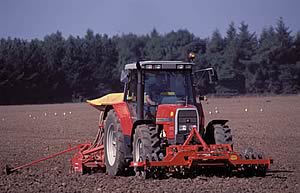 |
|||||||||
|
|||||||||||||||||||
|
|
Cultivate with Care to Avoid Further Soil Damage 30/09/08 Stay off your land until it’s fit to cultivate this autumn rather than rushing on regardless in an attempt to catch-up after the single most challenging harvest in recent memory.
Otherwise you will only compound the serious damage your soil has suffered from the pressure of harvesting under near waterlogged conditions over an extended period. “Thankfully, the recent rainfall respite has allowed most people to get their harvesting over with,” he notes. “Although for many in the north, Midlands and west, in particular, it’s been more a salvage operation than anything else. “It has also enabled ground to dry out well from the surface downwards. But it’s vital to appreciate just how much damage has been inflicted on the soil by wet weather combining and hauling. And the extent to which this damage will be made worse by trying to prepare seedbeds with heavy tillage kit before the ground can stand it. “There’s particular danger if your cultivation system involves tilling to depths of more than 3-4” because this leaves looser soils with more air incorporated into them, so ruts and compaction will be much deeper and more problematic,” he points out. “In contrast, the firmer, better structured soils left by shallow tillage will only be suffering compaction in their upper layers, and this can easily be dealt with in your primary cultivation.”
“More than anything else, the key to successful winter crop establishment without adding to your soil problems this season will be patience,” Steven Townsend insists. “This and having sufficient capacity and flexibility in your establishment system to go like hell when the conditions permit but hold-off when they don’t. “Getting winter cereals in will certainly be a challenge for many. But it’s surprising how quickly even the heavier soils have been improving with the drier spell we’ve seen from mid-September. So I’m confident most people should be able to get much, if not all, their planned cereal acreage in if we get a relatively open autumn. “Equally, I think we all need to appreciate that it won’t be the end of the world if some ground doesn’t get drilled ‘til the spring. Where soil conditions continue to be difficult this back end, indeed, it would be far better to wait and drill a spring crop rather than doing more damage to your ground by trying to muddle-in a winter one regardless.”
|
||||||||||||||||||

|
|
||||||||||||||||||
| home | agri-services | pedigree
pen | news | dairy | beef | machinery property | organisations | site map |
|||||||||||||||||||
